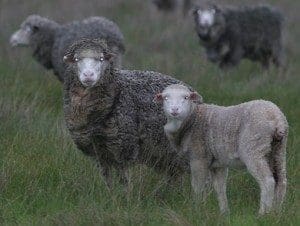
Merino ewes and lambs: losing ground.
MERINO to Merino matings continue to lose ground to sheep meat flock development nationally, according to the latest industry survey.
The latest February 2022 Meat & Livestock Australia and Australian Wool Innovation’s sheepmeat and wool survey results showed that 31 percent of producers are looking to increase their flocks, 60pc are going to maintain flock numbers and 7pc are going to reduce their flocks.
The survey indicated there were 42,351,464 breeding ewes on hand, 74pc are Merino, or wool producing, and 26pc are non-Merino. Breeding ewe numbers have increased by 1.1 million head as the flock growth continues, MLA said.
However, MLA’s market information manager, Stephen Bignell said compared to the survey at this time last year, the percentage of breeding ewes that are Merinos for wool production exclusively has fallen from 53pc to 51pc.
“Merino ewes (for wool and meat purposes) as a percentage of total breeding ewes have fallen from 76pc in February 2021 to 74pc this wave.”
Mr Bignell said overall nationally, ewe numbers grew 3pc in the last 12 months from 41.3m head, to 42.35m head, with breeding ewe numbers across all categories increasing in all states except in Western Australia (down 6pc) and South Australia (down 3pc).
At a national level, there was growth in ewe numbers of Merinos for non-wool production – 3pc — with increases of 10pc in first cross ewes, 40pc in dual purpose ewes, 4pc in shedding breeds and 12pc in other ewes.
“Nationally, Merino breeding ewes for wool production fell 2% from 21.88m head to 21.54m head –down 334m head.”
Mr Bignell said interestingly, Merino ewes for wool production increased in New South Wales, Tasmania and Queensland.
“In Victoria and WA the number of Merino breeding ewes used for wool production fell by over 7pc in both states.
“Nationally merino breeding ewes for other purposes increased 3% from 9.5m head to 9.74m head.”
Many of the non-Merino dominant farms are found in South Australia, Victoria and southern NSW. The Merino farms are found in northern NSW, QLD and the wheatbelt of WA. In NSW, the total breeding ewes has increased 8pc to 17.6 million but there are 15,300 less lambs on hand. This is the largest increase in breeding ewes across the nation year-on-year.
Mr Bignell said although there was growth in the number of ewes by over 1 million head, there was a fall of Merino ewes being used exclusively for wool production.
“This indicates that there is a movement towards other breeds and purposes.”
The survey showed that in the last four months between November 2021 and February 2022, there were 5.3 million lambs marked. Most of these were Merino lambs at 63pc, pure meat or terminal at 16pc and first cross at 9pc. There were 5.8 million ewes joined with national marking rates at 83pc for Merinos and 99pc for non-Merino breeds.
Mr Bignell said lamb sales are expected to remain in line with February 2021 results.
“Despite the number of lamb sales expected to remain constant, non-Merino and first cross lamb sales are expected to increase by double digit growth.”
The survey found that of the 19,487,990 lambs on hand, 56pc are pure bred Merino and 44pc are non-Merino. There were 1.1 million head more breeding ewes this year – numbers that are 3pc up year-on-year. This indicates that there will be increased activity in the mutton market throughout the rest of the year, MLA said.
MLA and AWI’s sheepmeat and wool survey provides a representation of flock populations, demographics, producer intentions and breeds, allowing MLA to make projections around the sheep meat industry.



HAVE YOUR SAY